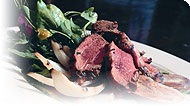health guides
The Zone Diet

The Basics
The Zone Diet was developed by Barry Sears, PhD, and popularized by his best-selling book, The Zone: A Dietary Road Map to Lose Weight Permanently: Reset Your Genetic Code: Prevent Disease: Achieve Maximum Physical Performance: Enhance Mental Productivity. Dr. Sears believes that the ideal diet should be 40% carbohydrate, 30% protein, and 30% fat. He also encourages athletes to follow a Zone Diet eating plan for maximum athletic performance.
- Zone dieters follow a 1-2-3 plan: for every 2 grams of protein, eat 3 grams of carbohydrate, and 1 gram of fat. There are very specific ways to achieve this ratio, which are outlined in Dr. Sears’s book.
- Choose low-fat protein sources like poultry, beans, or fish.
- Keep breads, starches, and grains to a minimum. Carbohydrates are classified as “favourable” (broccoli) or “unfavourable” (pasta). You can eat more of the “favourable” carbs and fewer of the “unfavourable” ones.
- Eating snacks is encouraged, and dieters are told to eat at least five times per day, and not to go more than five hours without eating either a snack or a meal.
Zone in: Start with lean protein sources like poultry and fish, fill in your meal with favourable carbohydrates, and round it out with a few nuts or olive oil. The Zone diet can be complex and confusing; consult a healthcare professional before making drastic changes to your eating plan.
More about this diet
The foundation of the Zone Diet is the relationship between the hormone insulin and substances called eicosanoids. Eicosanoids are hormone-like substances that control many vital physiological functions, including those of the cardiovascular system, immune system, and nervous system. Dr. Sears believes that certain eicosanoids are “good” and others are “bad.”
Here’s where insulin enters the picture. When insulin levels are high, “bad” eicosanoids are produced. Dr. Sears contends that his Zone Diet, which contains 40% carbohydrate, 30% protein, and 30% fat, is the ideal diet for keeping insulin levels in check. This translates to a 1-2-3 plan, where for every 2 grams of protein you eat, you should eat 1/2 that amount in fat, and 1 1/2 times that amount in carbohydrates.
Copyright © 2024 TraceGains, Inc. All rights reserved.
Learn more about TraceGains, the company.
The information presented by TraceGains is for informational purposes only. It is based on scientific studies (human, animal, or in vitro), clinical experience, or traditional usage as cited in each article. The results reported may not necessarily occur in all individuals. Self-treatment is not recommended for life-threatening conditions that require medical treatment under a doctor's care. For many of the conditions discussed, treatment with prescription or over the counter medication is also available. Consult your doctor, practitioner, and/or pharmacist for any health problem and before using any supplements or before making any changes in prescribed medications. Information expires December 2024.


 We are proud to announce that
We are proud to announce that  As the market evolves, customers increasingly request a wider variety of omega-3 options for their lipid...
As the market evolves, customers increasingly request a wider variety of omega-3 options for their lipid...  Maintaining healthy glucose levels is crucial for preventing metabolic conditions like diabetes,...
Maintaining healthy glucose levels is crucial for preventing metabolic conditions like diabetes,...  Looking at formulating a new vitamin blend? Discover
Looking at formulating a new vitamin blend? Discover 







































